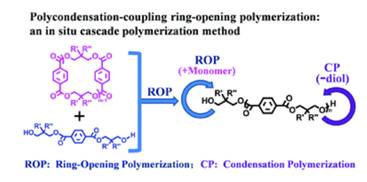PROP: an in situ cascade polymerization method for the facile synthesis of polyesters
Xiang Zhu,aJiali Gu,aXiaohong Li,aXiaoming Yang,aLian Wang,bYongjin Li,bHe Lic and Yingfeng Tu*a(屠迎锋)
a Jiangsu Key Laboratory of Advanced Functional Polymer Design and Application, State and Local Joint Engineering Laboratory for Novel Functional Polymeric Materials, College of Chemistry, Chemical Engineering and Materials Science, Soochow University, Suzhou 215123, China
b College of Material, Chemistry and Chemical Engineering, Hangzhou Normal University, Hangzhou 310036, China
c Key Laboratory of Marine Materials and Related Technologies, Ningbo Institute of Materials Technology & Engineering, CAS, Ningbo 315201, China
Polym. Chem., 2017, 8, 1953–1962
We present here an in situ cascade polycondensation-coupling ring-opening polymerization (PROP) method for the facile synthesis of polyesters with relatively high molecular weights that are hard to synthesize by traditional condensation polymerization methods. The method was developed during our studies on the melt polymerization of three poly(trimethylene terephthalate) (PTT) analogues with different lateral alkyl chains at the β-position of 1,3-propanediol, i.e., poly(2-methyl-1,3-propylene terephthalate) (PMPT), poly(neopentylene terephthalate) (PNT) and poly(2-methyl-2-propyl-1,3-propylene terephthalate) (PMPPT), from their corresponding cyclic oligoesters using diol initiators. Kinetic studies suggest that the systems follow the ring-opening polymerization mechanism at the early stages to form diol end-functionalized polyesters, while, subsequently, condensation polymerization starts between the polyesters at high monomer conversion regions. Inspired by the “domino reaction” concept in organic chemistry, the above in situ cascade polymerization process is attributed to a “domino polymerization” method. The structure–property relationship of these polyesters was investigated. It shows that the introduction of alkyl chains on the lateral side of propanediol segments increases the polyesters’ Tg by improving the chain stiffness, as those with higher modulus exhibit higher Tg, yet the gas barrier properties decrease with more or longer alkyl chains introduced. Our PROP method affords a facile way to synthesize polyesters and copolyesters with functional groups for potential application in materials science.

链接:http://pubs.rsc.org/en/content/articlelanding/2017/py/c7py00068e#!divAbstract